Fossil Flora - Silcrete Plant Fossils; Evidence for Climate Change - Part Two
 Sunday, March 10, 2013 at 8:58PM
Sunday, March 10, 2013 at 8:58PM Hartley, 1967 stated “The past is a foreign country”
The validity of this statement becomes readily apparent looking across the vista of breakaways, dry sandy terrain, silcrete-covered ridges and dry gibber desert. A stark contrast exists between the present day environment and the evidence presented by fossil flora of the very different conditions that prevailed here, when the fossils were deposited. What had previously been a wet, lush, and green environment that supported a complex mosaic of tropical and temperate rainforest, is now devoid of all but the most resilient vegetation.
The content of this post, because of its scientific nature is rather specialised, however, I have attempted to succinctly explain the region’s local geology and provide evidence to how the fossils found in the area can be used to interpret climatic change. To view an image larger, double click the image.
The region’s geology has been poorly studied, despite there being considerable interest because of the record of surface environments in the Eyre basin over the past 40 million years, and the famous silcrete floras and mammalian megafauna.
LEFT: A satellite view of the region (courtesy Google Maps) clearly showing the drainage lines (green), gibber plains (light brown) and breakaways (dark brown).
The geology is complex, in part because of the number of stratigraphic units involved and the interrelationship between lacustrine, fluvial, and aeolian sediments. It’s this interrelationship and the variable development of duricrusts which has recently propelled the region’s interest, as these environments provide good scientific analogues for the surface of Mars.
The basement rock is comprised of marine deposited shale laid down during the Cretaceous Period when much of what is now inland Australia was covered in seawater. The break-up of Gondwanaland and resultant rearrangement of tectonic plates gently deformed and duricrusted this shale, named the Bulldog Shale, to form the gibber plain uplands of the Stoney Desert. The breakaways, prominent sentinels in today’s environment, are comprised of fluvial and lacustrine-derived sediments deposited during the Upper Triassic and Lower Tertiary, and were formed by erosion from several ephemeral streams including Coopers Creek.
Sedimentology and Palaeoenvironments
I’ve attempted to provide a short introduction to the sedimentary units involved in the formation of the palaeochannel in which the fossils have been deposited. This interpretation is quite broad in content and further study and work needs to be done to accurately assign dates to the various stratigraphic units.
The nature of the palaenvironment is well understood; a fluvial system with well-established oxbow lakes and shallow lakes surrounded by a mosaic of riparian tropical to temperate rainforest in a warm semi-tropical climate.
LEFT: Indistinct to the untrained eye, this sandstone rock exhibits tell-tai sedimentary structures which indicate that the region was once covered in water. The ripple marks can be used, amougst ither things, to interpreete water depth and current direction.
During the mid-Tertiary, the environment began to experience seasonality with fluctuating watertable levels; increased periods of semi-aridity began to alter the rainforest mosaic until species survived only around permanent water channels and lakes. Eventually, as Australia and Antarctica separated and Australia moved north, aridity became more widespread and taxa became locally extinct.
The Watchie Sandstone Unit
The Watchie Sandstone is a lacustrine sequence comprising; in upwards succession, a local channel-sand facies and widespread lag deposits, a transgressive fine-grained lacustrine facies and regressive strandline deposits with a wavebase lag.
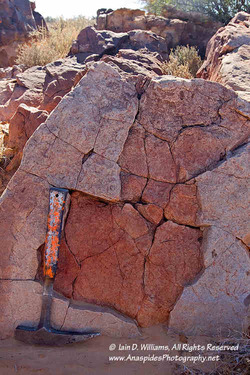 Lag deposits indicate a low-gradient surface and strandlines incorporating pedogenic silcrete clast provide evidence of former soil horizons. The palaeocurrent evidence is consistent with longshore processes and bar accretion onto a foreshore and larger bedforms indicate storm events. Ridges have formed only along the eastern shoreline, indicating a strong westerly airstream and silicification and ferruginisation alternated during lacustrine regression.
Lag deposits indicate a low-gradient surface and strandlines incorporating pedogenic silcrete clast provide evidence of former soil horizons. The palaeocurrent evidence is consistent with longshore processes and bar accretion onto a foreshore and larger bedforms indicate storm events. Ridges have formed only along the eastern shoreline, indicating a strong westerly airstream and silicification and ferruginisation alternated during lacustrine regression.
Insects (including ants and termites) lived in developing soil profiles and rhizonodules indicate that plants grew on these soils.
The Willalinchina Sandstone Unit
This unit was deposited in a fluvial channel environment and is interpreted as a broad, shallow meandering to braided channel system which abuts a floodplain to a lacustrine palaeoenvironment. Storm and associated flood events have also deposited bar, levee and floodplain deposits which interfinger with fluvial-derived sediments.
LEFT: Partly eroded to show depth of the deposit, the structures clearly are indicative of sequential mud cracks that provide evidence of a drying environment.
Field observations support this interpretation: A thin lens of basal conglomerate has been overlain by several meters of cross-bedded fine to medium-grained sandstone containing minor 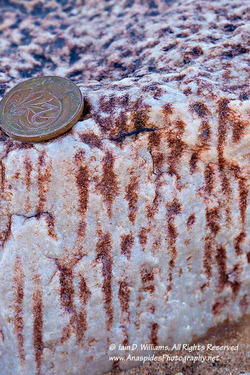 lenses of course-grained sandstone. Silicification, caused by alternating watertable levels, has occurred in several places.
lenses of course-grained sandstone. Silicification, caused by alternating watertable levels, has occurred in several places.
Silcrete and Silicification
Silification provides evidence of a fluctuating watertable and, in general, a marked seasonality toward aridity, which inland Australia experienced during the mid Cenozoic.
LEFT: Reed mould or ant's nest silcrete - a possible interpretation is reed casts or methane gas escape structures from rotting vegetation.
The silcrete is defined by closely spaced vertical structures which have been referred to in past literature as “ants nest or reed mould silcrete”. The vertical structures have been interpreted as reed casts, however, there is no evidence of organic matter found within the Willalinchina Sandstone Unit. A possible alternative is soft sediment deformation caused by gas escaping from rotting vegetation. This scenario would explain why the gas escape structures are not evident throughout the sandstone unit, but are preferentially preserved.
Another interesting sedimentary structure preserved within the silcrete are circular mound-like features (below left) which have not been successfully interpreted. One theory suggests that the features are formed when liquid silcrete bubbled its way toward the surface, akin to how artesian water 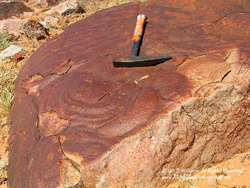 bubbled to the surface in nearby artesian spring moulds.
bubbled to the surface in nearby artesian spring moulds.
Silcrete is an indurated soil duricrust formed when silica is dissolved and resolidifies as a cement. It is a hard and resistant material, and though different in origin and nature, appears similar to quartzite. Silcrete is relatively common in inland Australia, often forming the resistant cap rock on features like breakaways.
Stratigraphic Analysis and Age
Sediments from the Palaeochannel have been placed in the Watchie and Willalinchina Sandstone units although most of the palaeochannel area is located within the later.
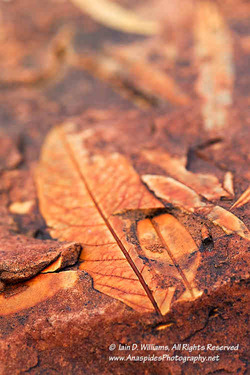 Preliminary palaeobotanical work suggests that the Willalinchina Sandstone correlates with the youngest phase of the Eyre Formation in the Lake Eyre Basin and is Eocene in age. The Watchie Sandstone has been interpreted as Miocene and correlates with the Billa Kalina Basin. However, recent stratigraphic analysis may indicate that the Willalinchina Sandstone could be Miocene to Pliocene in age. Further investigation needs to be made in this area before a definite date can be attributed to the palaeochannel.
Preliminary palaeobotanical work suggests that the Willalinchina Sandstone correlates with the youngest phase of the Eyre Formation in the Lake Eyre Basin and is Eocene in age. The Watchie Sandstone has been interpreted as Miocene and correlates with the Billa Kalina Basin. However, recent stratigraphic analysis may indicate that the Willalinchina Sandstone could be Miocene to Pliocene in age. Further investigation needs to be made in this area before a definite date can be attributed to the palaeochannel.
Floral Record - Interpreting Climatic Change
The Australian Tertiary plant fossil record is very poor. Studies indicate that tropical to temperate rainforests occupied south eastern and south western Australia for much of the early-Tertiary with a contraction of these rainforest communities in the mid to late-Tertiary.
LEFT: One of many example of the fossil flora found in the area. The state pf preservation is amazing and identification, in some cases, to species level is possible.
The discovery of the fossil flora confirm the palaeochannel is one of the richest, most extensive Tertiary plant fossil localities in Australia, if not globally.
The botanical significance of silcrete fossils may be limited because silcrete formation is notoriously difficult to interpret and date with precision; however, the presence of extensive silcrete, caused by the fluctuating watertable levels does provide evidence consistent with marked climatic seasonality that occurred in inland Australia during the Cenozoic. Therefore, floral assemblages could preserve evidence of the effect of climate change on the vegetation of inland Australia.
Initial Analysis
Initial analysis of floral elements indicate a mosaic of plant communities dominated by sclerophyllous woodlands (Eucalypt spp.) and interspersed with riparian rainforests and deciduous marginal monsoon forests. These plants grew along the watercourses where permanent water enabled them to survive seasonal dry periods.
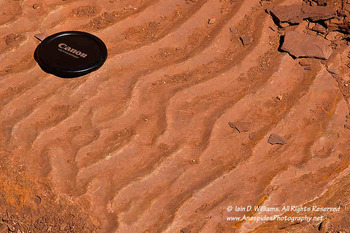 Interpretation of Fossil floras and Palaeoclimate
Interpretation of Fossil floras and Palaeoclimate
Observational studies in tropical and temperate forests have demonstrated a direct relationship between leaf form (foliar physiognomy) and local climate. For example; leaf length to leaf width and stomata number and size correlate to rainfall and ambient temperature.
LEFT: Ripple marks showing bifurcation of ripple crests indicate wave-formed ripples that have formed by wind blowing across shallow water. The ripple marks are so clear, it's difficult to realize that they were formed approximately between 24 and 5 million years before present.
Mean canopy leaf size is also strongly correlated with mean annual temperature. Palaeobotanical investigations of the botanical specimens found within the palaeochannel (Willalinchina Sandstone) provides valuable information on the mid-Tertiary distribution of Eucalyptus spp. and other plants.
To date 245 leaf types, 47 fruit and seed types and 2 major wood types have been identified. The sclerophyllous component (identified from linear to lanceolate leaf forms) dominated the flora and would have grown on the exposed drier plains in the more open forest areas of the floodplain.
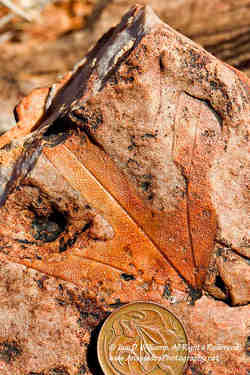 Many of the fossil leaves are indiscernible from extant Eucalyptus leaves and the minimal variation in leaf form suggests that Eucalyptus has existed in the area for ~15 million years. The ecological niche of this species, based on this information, appears to be similar to that of extant Eucalyptus.
Many of the fossil leaves are indiscernible from extant Eucalyptus leaves and the minimal variation in leaf form suggests that Eucalyptus has existed in the area for ~15 million years. The ecological niche of this species, based on this information, appears to be similar to that of extant Eucalyptus.
LEFT: An excellent example of Banklsieaeformis praegrandi. If you open this image (double click) you can see the preserved intricate patterns of the veins that have been preserved. The red colour is caused by iron oxide that has percolated through the sediments.
The rainforest component of the flora grew in areas that provided a permanent water resource and are not present in the area today; their absence indicative of a changing climate and environment. As the climate became increasingly drier, these plants died out to eventually become confined to the present monsoonal and tropical rainforests of northern Australia and became locally extinct.
Ancient Eucalyptus are not the only plant fossils that have been uncovered; numerous other plant species are likely to be extinct representatives of extant genera. As with the Eucalyptus, similarity in leaf forms between fossil leaves and extant leaves have made identification problematic and it’s highly likely that many of these species were intermediate rainforest / sclerophyllous species sandwiched between the effects of climate change.
One species that appears to have been positively identified from its deeply incised proteaceous leaf form is Banklsieaeformis praegrandi. This fossil plant has been found in low numbers within the palaeochannel and has been linked to the extant species Banksia chamaephyton which is restricted to a small area of heathland in Western Australia (Greenwood, 1997).
Access to this area is STRICTLY PROHIBITED without express permission from the land owner, property station manager, and approval from an educational facility such as University or museum. Removal of fossils or collecting is NOT ALLOWED.
LEFT: Preferential erosion erodes the former land surface to leave the more harder and durable silcreted surface, in a formation called a breakaway; a term uniquely Australian. The breakaways can reveal the surface of an environment that often is completely changed to that of today. It's often difficult to grasp that approximately 70 million years ago these surfaces were the floor of a vast inland sea.
Next Journal Post
In the final post on this topic, we'll look at a number of photographs of the fossils and discuss the best method to photograph them in situ.
References
Krieg, G. W., Rogers, P. A., Callen, R. A., Freeman, P. J., Alley N. F. and Forbes, B. G., 1991. Explanatory Notes Curdimurka South Australia. 1:250,000 Geological Series Geological Survey of South Australia, Peacock Publications, pp 35 – 38. Rowett, A., 1997. Earthwatch '96. MESA, Journal 5, pp 27-29.



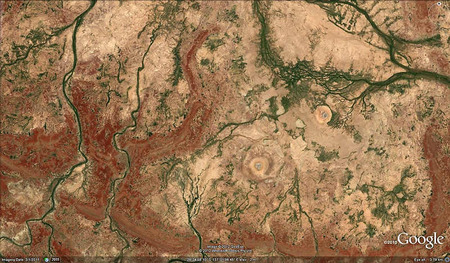
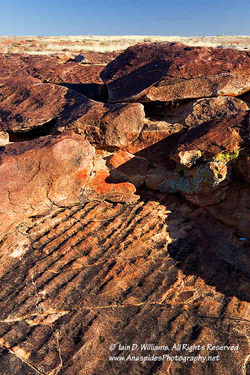
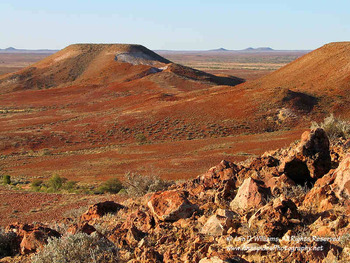
Reader Comments